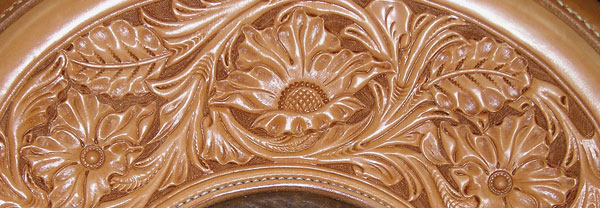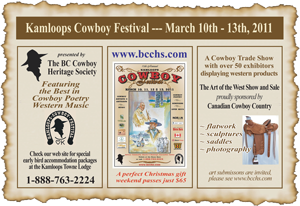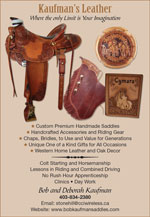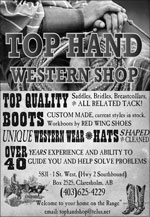Taking Care of Your Gear – From Rawhide to Silver

For years, Cowboy Country magazine has been a virtual parade of beautiful handcrafted gear. Fine examples of intricate horsehair hitching, stunning silverwork, artistic bits and metalwork, fine leathers worked in a myriad of forms and of course, elaborately braided rawhide Whether you keep your gear in a showcase or use it every day, it will require maintenance to look its best and to prolong its life.
Always remember: as with horses, there is such a thing as “killing with kindness”, so take care not to overdo the cleaning, oiling or polishing.
Braided Rawhide
Braided rawhide requires minimal care and cleaning is rarely necessary. The best thing for rawhide gear is use.
If cleaning is absolutely necessary, and if your rawhide is white, use white saddle soap. If your rawhide is yellow , use yellow saddle soap. (Fiebing’s makes yellow, white and black saddle soap.)
If you must clean it, dampen a soft rag and rub it in saddle soap to create foam. Apply the foam to the rawhide and allow it to lift off the dirt. For lodged dirt, try flicking it out with a nail brush. (See sidebar.) Immediately wipe it off with a clean, damp rag. Never immerse the piece in water and keep it as dry as possible.
Drying Rawhide
Reins should be hung absolutely straight to dry in a cool place out of direct sunlight. Make sure they are not touching metal to avoid rust. If necessary, use a string through the romal loop rather than hanging them directly from a metal hook or nail.
A cousin of mine (“just call me a chubby twister,” he says) told me the best way to look after your rawhide-core bosal with a horsehair mecate is to hang it up properly. Hold your bosal hanger in your left hand with the heel knot pointing to your right. Pick up the middle of the mecate rein and coil one loop (like a lariat) towards your body. Coil the rest of the mecate in a couple of big loops, again, towards your body. The reason for this is because mecates are made with a right-hand twist. Coiling it in this way counteracts the twist and will make the rein hang straight. Hang over a rounded peg with the heel knot closest to the wall
Conditioning Rawhide
Contrary to what’s on the Internet, rawhide does not need conditioning. If you feel you MUST, apply the tiniest amount of R.M. Williams Saddle & Leather Dressing. Seriously; the tiniest amount you can imagine. Contact your rawhide braider for advice.
There is a rumour that after cleaning, rubbing in saddle soap and leaving it on your gear will condition rawhide. It won’t. All soaps contain lye, even glycerine and saddle soaps, and that’s definitely something you don’t want sitting on your rawhide. Also, imagine what happens to your soaped-up reins when it rains…
For rawhide reatas, braider Vern Ballantyne says that a new reata has to be broke in. During this process he will use a tiny amount of R.M. Williams. A properly broke in reata will last for years. For advice on how to break in a reata, contact your rawhide braider.
The bottom line is: the best way to maintain your rawhide gear is to use it well and take pride in its patina.

Metals
Patina — to remove or not to remove; that is the question
Patina is the weathered look on metals, wood and leather that comes from exposure,
oxidation and wear. To remove the patina is often a personal choice. Many like their gear to reflect its history; some buy gear with an artificial patina (rusty rein chains, distressed leather for chaps, etc.,) so their gear looks like it has some history, while others like their gear shiny. Personally, I’m proud that I can occasionally afford custom gear so I clean and polish everything. But again, it’s personal preference.
Brass
Stirrups, hardware, buckles, harness brasses
With a clean cloth, apply a thin, even coat of brass cleaner of your choice (I use Peek) and follow manufacturer’s instructions. Buff to a shine. Apply a thin coat of wax (I use Conservator’s Wax, see sidebar) to slow down oxidation. To speed things up I use buffing “mushrooms” of soft cotton that attach to my drill — one for cleaning, one for polishing.
Silver
Silver looks best with patina as it highlights the engraving, but here in Alberta there’s so much sulphur in the air that tarnish is almost instantaneous. (A nice patina is one thing; but a black mess is another.)
One cleaning method used by silversmith Esther Nagel is to mix a couple of drops of dishwashing liquid into a dash of ammonia (in the States you can buy this mixture; it’s called sudsy ammonia) and buff your silver with this mixture on a soft cloth. To get into the engraving, use the recommended nail brush. (See sidebar.) Another method is to apply commercial silver polish sparingly, buff and polish to a high shine. (It can sometimes be difficult to get polish out of the engraving though.) Apply a thin coat of Conservator’s Wax to prevent oxidation.
Blued Steel
Bluing is an electrochemical passivation process to partially protect steel against rust that results in a very thin coating of blueing. To clean, wipe with a damp, soft cloth, dry thoroughly and wipe on a thin layer of gun oil and buff. Don’t handle blued steel with dirty hands as the grease will leave permanent finger marks.

Hitched Horsehair Shoo-fly’s
I have successfully used two-in-one shampoo and conditioner to clean two very dirty shoo-fly’s that hung on my harness bridles. The hitching was gently scrubbed with shampoo and the recommended nail brush. (See sidebar.) Rinse thoroughly with cool water and hang to dry.
Hitched horsehair belt with leather backing The least invasive way to clean hitched horsehair belts is to use Groom Stick. The product will remove dirt, grease and oil.
(See sidebar.)
Angora Chaps Woollies
Beautiful, warm and they shed water; Angora chaps are made with hair-on Angora goat hides backed with canvas or leather. The least damaging way to clean your woollies is allow them to dry thoroughly.
Gently brush the dirt off with a small brush. Brush sparingly; you want to maintain the twists and prevent the angora from poofing out like a scared cat. If chaps are seriously soiled with grease or oil, use Groom Stick.
OILS
What To Use, Where to Use It
You will never go wrong with these rules for applying oil:
• Use petroleum or mineral oil
on metal
• Use vegetable oil on vegetables
• Use animal product oil (100-per-cent Pure Neatsfoot Oil) on leather.
Apply it SPARINGLY!!!
Know Your Oil!
Pure Neatsfoot Oil is a yellow oil rendered and purified from the shin bones and feet (but not the hooves) of cattle. (“Neat” comes from an old name for cattle.)
“Prime neatsfoot oil” or “neatsfoot oil compound” are terms used for a blend of pure neatsfoot oil and non-animal oils, generally mineral or other petroleum-based oils. Don’t use this on leather.
(Note: Ken Cameron has successfully washed old Angora’s. Following his instructions, I will be conducting an experiment washing Angora hide backed with canvas and Angora hide backed with chap leather. Check my blog at www.cowboycountrymagazine.com for the results and for other gear-cleaning tips.)

Stains on Leather
Thanks to saddle and gear maker Deryk Pitts for this tip: For anyone that has mice scampering — and piddling — on saddles in the tack room, then oxalic acid is your friend; it will take the urine stain off your leather saddle seat like magic.
To remove urine (and other) stains from leather: Wear gloves. Apply a small amount to a wool pad and gently rub the affected area. It will immediately remove the marks. Apply a light coat of pure Neatsfoot Oil over the treated area. You might also want to get a cat.
If You Don’t Own It, Don’t Touch It
For the benefit of all the trappings and gear makers I would like to add this point; when you are admiring handcrafted gear that is for sale — don’t touch it without permission. It’s one thing for a buyer to handle it; but imagine the damage caused by thousands of curious people with dirty, greasy hands at a busy trade show.
If you can’t resist, ask permission, then put on your clean gloves (cotton roping gloves) before handling. Better yet, buy it first — then touch the gear all you want.
Outside of making it yourself, nothing brings as much satisfaction as custom gear. I believe it is the ultimate reward and reflects an appreciation for traditional cowboy arts. Bring your design ideas — and ride into the unique world of custom gear.
Share Your Wisdom
There are a lot of savvy people out there in Cowboy Country and we’d like to share your proven ideas, tips and tricks for cleaning and care of gear. Let us know by emailing your advice to editor@canadiancowboy.ca. We’ll post your expertise on our website at www.cowboycountrymagazine.com
For those of us who are really picky…
Groom Stick
Groom Stick is a neutral pH, natural kneadable rubber (think Silly Putty™) that picks up everything from dust, grease and mould from engraved metals, leather, horsehair and rawhide; permanently tacky, reusable. I buy it online.
Conservator’s Wax
Conservator’s Wax is highly refined microcrystalline waxes. Used in museums, this crystal-clear wax provides moisture resistance and protection against heat and finger marks on wood, metal, polished stones, leather, cast resins — even photographs. Lee Valley Tools carries it.
World’s Kindest Nail Brush
Available from fine woodworking stores (such as Lee Valley Tools), these 3” x 2” soft plastic nail brushes feature 1,660 fine bristles; they will wick out dirt and will not scratch.
Special thanks to braider Vern Ballantyne, Ken Cameron of K.C. Saddlery, Don Wudel and Ken Murray of Caledon Leather, horsehair hitcher, saddle & gear maker Bob Kaufman and silversmith Esther Nagel and saddle & gear maker Deryk Pitts of Deryk Pitts Saddlery for their expertise.
Terri Mason is the editor of Canadian Cowboy Country and uses all her custom gear on her Super Cowhorse, Woody.
 |
 |
 |
